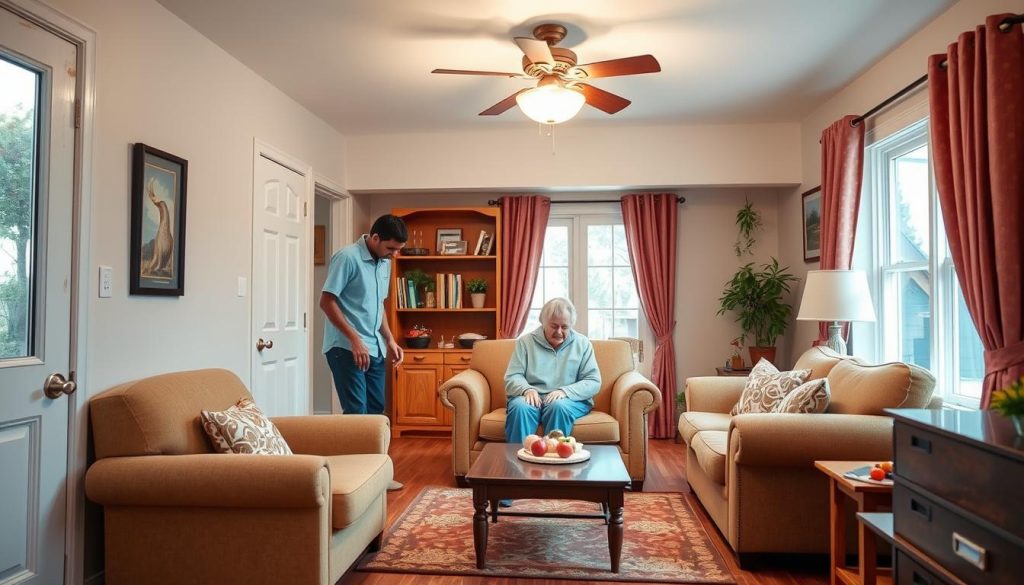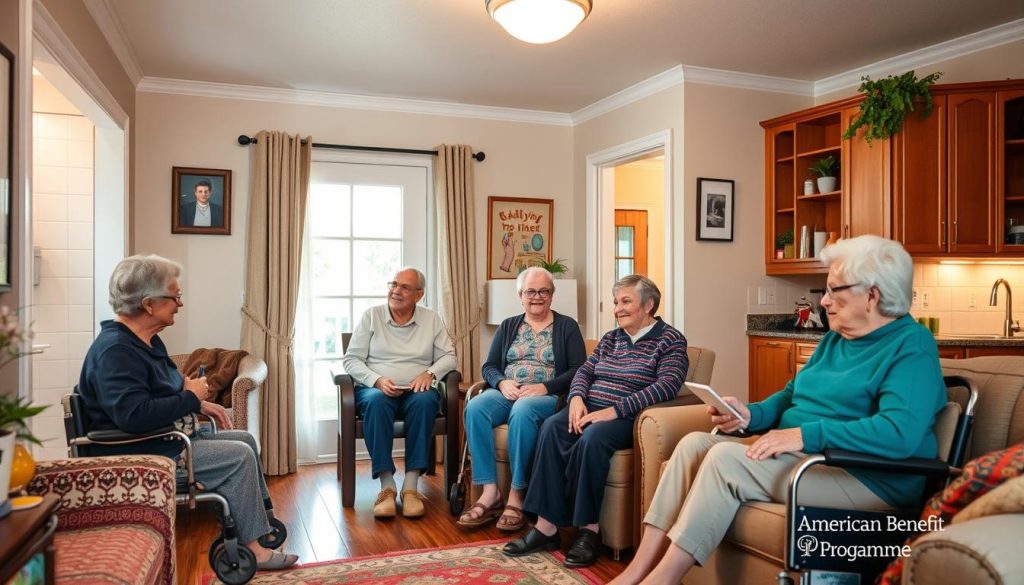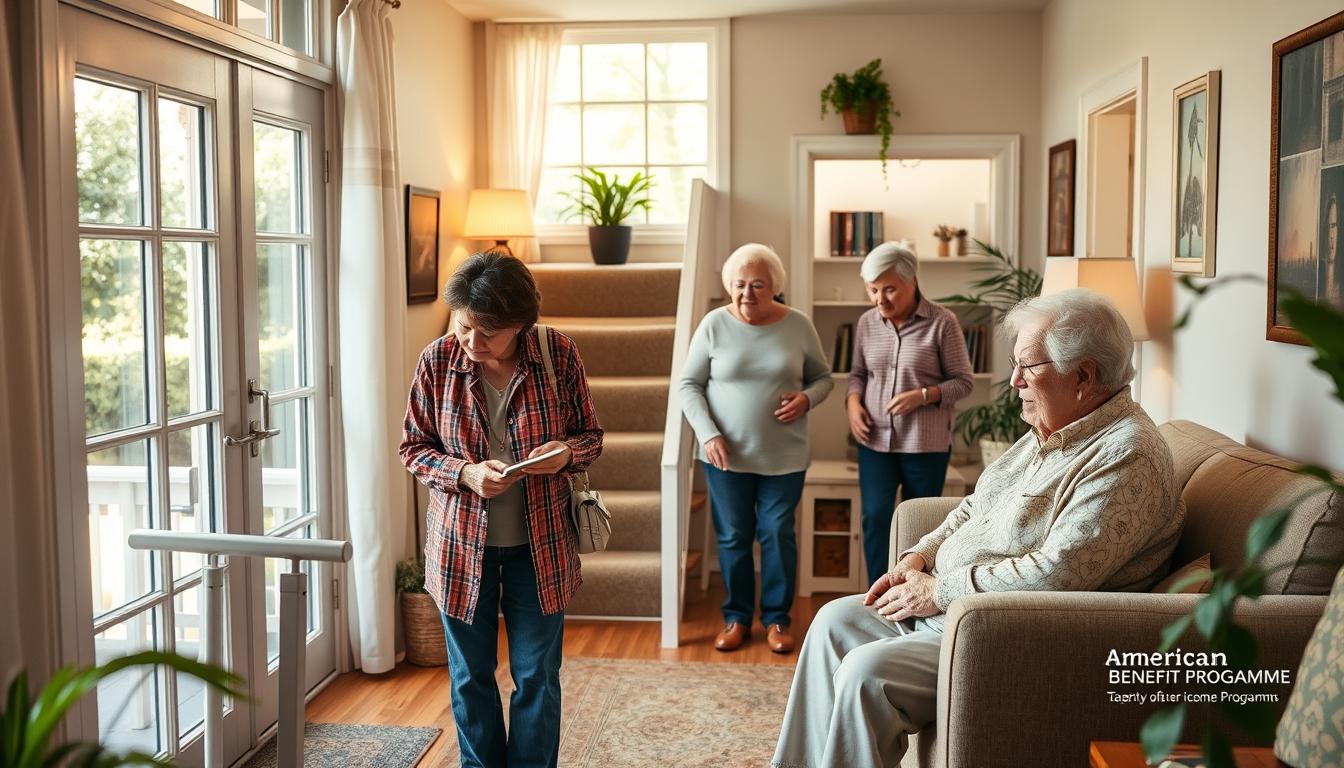Have you ever thought about how you or loved ones can stay safe and independent at home? This guide shows key ways to make living at home better for seniors. It helps them stay in their own homes as they get older1. More than 75% of older people want to stay in their homes as they age. We’ll look at the best methods, changes, and tech to support this goal. We’ll share tips on making homes safer and easier to live in. This lets seniors live well on their own.
Key Takeaways
- Understanding the significance of planning ahead for aging in place.
- Identifying key areas to modify in homes for enhanced accessibility.
- Utilizing technology to promote independence and safety.
- Connecting with robust support networks to prevent isolation.
- Recognizing the importance of personalized care and nutrition.
Understanding Aging in Place
Aging in place means older adults stay in their homes as they get older. They find comfort and familiarity there. About 76% of people aged 50 and older want to stay in their homes as long as they can2. By 2030, 1 in 6 people will be 60 or older. This shows a big need for good care at home2.
Also, a huge 88% of those aged 50 to 80 don’t want to move2. This shows how much they love their homes and want to keep their freedom.
But, only 15% have thought about making their houses safe for aging2. Adding grab bars or making homes wheelchair-friendly is key for safety and living independently3. The cost of home care varies a lot. It can be from $20 to $200 per hour3.
It’s also important to know about extra costs. Like higher property taxes or maintenance costs, which can be $5,000 to $10,000 more each year3. As more people turn 65, reaching 80 million by 20304, communities need to help support this lifestyle. This means making sure the right services are there.
The Importance of Planning Ahead
Planning early helps people stay in their homes as they grow older. A study by AARP shows 77% of adults wish to age in place. This number jumps to 88% for those over 5056. It’s important to plan for changes in health and home needs.
About one-third of older adults find their homes not fully ready for aging6. Simple changes can make a big difference. For example, adding grab bars or using non-slip floors increases safety5. Home health aides also provide essential support5.
It’s vital to build a support plan with family, friends, and doctors5. Being active in the community helps avoid loneliness. By planning ahead, people can live well and independently in their homes.
Key Areas to Modify for Aging in Place
Creating a safe and cozy home is key for older adults who wish to stay at home as they age. Making small changes in the home can make it easier and safer for them to live on their own. Here are some key changes to think about:
- Widening doorways to a minimum of 36 inches for better access with walkers and wheelchairs7.
- Installing grab bars in hallways, at heights between 32 and 34 inches, helps with balance near doors and corners7.
- Creating hallways at least 36 inches wide makes moving around easier7.
- Adding handrails on both sides of stairs, and making sure they extend past the steps, increases safety7.
- Ensuring there’s a 36-inch space between furniture and paths makes using mobility aids simpler7.
- Lowering kitchen counters to 28 and 30 inches high makes them more user-friendly7.
- Choosing lever faucets in kitchens makes turning water on and off easier8.
- Putting non-slip floors in kitchens and bathrooms helps prevent falls7.
- In bedrooms, opting for flooring like low-pile carpet or cork keeps surfaces safe7.
- Making sure the area around the bed is clear prevents trips and falls7.
- Switching out bathtubs for walk-in showers with low steps can improve bathroom safety7.
These home updates focus on making spaces easier to use for those growing older. It’s important to keep checking these changes as seniors’ health and ability to move around may change.
Aging in Place Solutions for Home Safety
Keeping seniors safe at home helps them stay independent. It starts with checking the home for dangers. Hazard identification means looking for things like shaky stair railings, and too much furniture. It also includes checking for places that need more light.
Identifying and Addressing Hazards
Over 19 million older adults live in homes that aren’t safe for them9. It’s important to check the house often for dangers. Things like clutter or not enough light can make falling more likely. Every year, 1 in 4 people over 65 fall down and get hurt10.
Implementing Safety Features
Adding safety items can make a big difference. For example, grab bars in the shower help prevent falls10. Putting handrails by stairs and porches also helps everyone. It can make your home worth more too10. Also, tools like dumbwaiters make daily tasks easier and safer10.

Elderly Home Modifications for Accessibility
It’s key to make homes safe and cozy for older folks. Changes to their homes make day-to-day life easier. The main spots to fix are bathrooms and kitchens. These upgrades are big for safety and making things easier to use.
Bathroom Upgrades for Safety
Making the bathroom safer helps stop falls, which are common in older people. Adding walk-in showers, grab bars, raised toilet seats, and mats that don’t slip helps a lot. These changes mainly help because many falls happen in bathrooms11. The cost for making a bathroom safer can be between $150 to $2,00012. Using experts for this work makes sure everything is safe and right12.
Kitchen Adjustments for Ease of Use
Making the kitchen easy to use is important for older folks who want to stay independent. Small changes like making counters the right height and adding sliding shelves make a big difference11. Also, choosing handles that are easy to grab helps a lot. Making doorways wider and the room brighter also makes kitchens safer and easier to move around in13. A kitchen that’s easy to use helps older people cook and spend time with family without trouble.
Senior Accessibility Products You Need
To help seniors stay independent at home, many products are available. These include tools to help move around and gadgets that make living safer. Most seniors, over 75%, want to live in their homes for as long as possible. This shows how important these tools and gadgets are14.
Mobility Aids
Mobility aids are key for seniors to move around their homes. For example, about 25% of seniors aged 65 and up used a mobility aid in the last month15. Here are some common aids:
- Walkers
- Canes
- Electric stairlifts, costing between $2,200 to $16,000, provide safe access to different floors16.
- Wheelchairs, important for those who have a hard time walking, cost about $7,500 to $12,00016.
Smart Home Devices
With tech getting better, smart home devices are now key for senior safety. Devices like personal alert systems can save lives by calling for help during emergencies14. Here are some smart technologies:
- Automatic lights that make paths bright at night to lower fall risks.
- Voice-activated helpers for staying in touch and managing daily tasks.
- Fall detection sensors that tell family or emergency services if a fall happens.
Using these products can make life safer and more independent for seniors. It helps especially for those who find it tough to walk or climb stairs. About 30% of seniors 65 and older have this difficulty. If you’re thinking of making your home safer, it’s vital to check your options for comfort and safety.
Aging in Place Technology: Enhancing Independence
Aging in place technology helps older people stay in their homes longer. Things like smart home technologies do tasks around the house. This makes life safer and more comfortable for them. Technologies like generative AI could add a lot of value, up to $4.4 trillion17. Personal emergency systems also help a lot. They use GPS and can talk both ways. This means seniors can get help fast if they need it18.
There’s also wearable technology. It watches health signs like heart rate and how much you move. This helps seniors take care of their health before problems start. Many older adults, about 35%, use wearables to watch their health, especially if they take many medicines18.
Remote support has changed how older people see their doctor. It’s really good for those who find it hard to move around. A study showed that older adults want to help design AI aids. They like using technology in their lives19. Robots that help with everyday tasks are also popular. They make things easier for caregivers and let seniors keep doing their routines.
All these technologies make living alone easier for seniors. They also help keep close to caregivers and family. This is great for meeting the many needs of aging people in their homes.
Aging in Place Services to Consider
Aging in place helps seniors stay independent in their homes. Many seniors like this as they get older and need help20. They have many services to choose from, like home healthcare and help with everyday tasks.
Programs like Meals on Wheels bring food right to their doors. This shows how important it is for seniors to get meals easily20. Transportation helps them get to doctor’s appointments and fun places20. Services also help them with chores and getting medicine, so they can stay healthy20.
Companion care means someone is there to help clean and assist with daily tasks20. Personal care aids those who have trouble with dressing and bathing20 and21. Special care is there for serious conditions like Alzheimer’s, giving them the right support20.
It’s important for seniors and their families to know these services. Many over 65 may need help21. They cover housework, personal care, and health needs, helping seniors live at home longer21. Often, seniors lean on their families, showing the need to work together in care21.

Choosing the Right Aging in Place Contractors
Finding the right aging in place contractors is crucial. It helps make sure the home fits the needs of older adults. About 70% of these contractors have special certificates showing they know what they are doing22. It’s important to look at their skills and ask important questions. This helps pick the right person for the job.
What to Look For
When looking for a contractor, check their experience and if they have the right license. They should also have a good history of making homes better for seniors23. Almost all seniors want to stay in their homes as they get older. Make sure the contractor is a Certified Aging in Place Specialist (CAPS). This means they have the right training to help older adults24.
Questions to Ask Potential Contractors
When talking to contractors, ask them important things about their work. Ask about their past projects and how they plan to update your home. Here’s a list of key questions to ask:
- What is your experience with aging in place modifications?
- Can you provide references from past clients?
- How do you ensure clear communication throughout the project?
- What is your process for handling complications or unexpected changes?
- Can you provide a detailed estimate, and how many contractors do you recommend contacting for comparisons?
Most people think the contractor’s experience is more important than the price22. It’s a good idea to talk to 3-4 contractors. This helps you compare what they offer better22.
Insurance and Financing Options for Aging in Place
It’s important for seniors and their families to know about money matters for aging at home. 90% of older adults want to stay in their own homes as they age. They can look into different insurance options and government help to pay for health care25. By using these resources and making their homes fit their needs, seniors can save money26.
To help pay for staying at home, getting long-term care insurance is key. This insurance helps cover in-home care costs, which can be a lot. For example, services at home can cost about $38,095 to $42,168 a year25.
Seniors can also use reverse mortgages to get money from their home’s value. This money can help pay for needed changes to their homes and care. These choices depend on what each person needs and how much money they have26. Knowing all these money options helps older people and their families plan better to stay independent.
Medicaid and Medicare, federal programs, are also crucial for paying for home changes and care. In 2009, Medicaid paid for 62% of nursing home costs25. It’s smart to look into all possible help to best plan for aging at home.
| Care Type | Median Annual Cost (2020) | Monthly Cost Comparison |
|---|---|---|
| Homemaker Services | $38,095 | $3,174 |
| Home Health Aide | $42,168 | $3,514 |
| Assisted Living Facility | N/A | $4,500 |
| Nursing Home (Semi-private Room) | N/A | $7,908 |
Creating a Support Network for Seniors
Having a good support network is key for seniors wanting to age well at home. Family plays a big part in making seniors feel loved and backed up every day. When family helps with care, it does more than just help with daily tasks. It fights loneliness too. The number of people living alone has gone up a lot since the 1980s. This shows why a good support network is needed27. U.S. Surgeon General Vivek Murphy called loneliness a big problem. He said we need to make better connections27.
Involving Family and Friends
Having family and friends help care for seniors can make their life better. It’s important to check on elderly parents often. This helps us see if they’re okay and keeps them feeling connected28. A strong network of family, friends, and neighbors means seniors get help when they need it. This makes them feel safer living on their own. Did you know older adults with good friends live about five years longer than those without27?.
Community Resources for Assistance
Communities are key in supporting seniors, too. Local groups provide important services like meals and rides, helping seniors stay independent. For instance, a place in Charleston, SC offers fun gatherings and help groups for older folks28. Getting help from the community takes some burden off families. It also helps seniors feel they belong. This is really important for seniors who might feel left out, like immigrants or LGBTQ seniors. They face more risks of being alone27. Adding these resources into a senior’s life can help a lot.
Conclusion
Growing old at home is key for older folks wanting to keep their freedom. It lets them stay in a place they know well. A lot of them, about 89 percent, wish to stay in their homes as they age. This shows a big need for planning ahead29.
Adding the right home changes, new tech, and strong support services is very important. These things help make sure older people are safe and happy.
Helping older people isn’t just important; it’s also a chance to give them power. Our guide talked about how to live independently, the role of friends and money in home care, and more3031. Families can help by being there emotionally and doing fun activities together. This helps fight loneliness and keeps their minds strong.
A plan that includes friends, new tech, and customizing homes can make a big difference. It allows older adults to live with respect in their later years29. They can stay in their homes, get the right help, and do well. For more details on this, click here.
Source Links
- Aging in Place with In-Home Care in the US | ComForCare
- Aging in Place in 2023: What It Is and What You Can Do
- What is Aging in Place? Pros and Cons of Aging in Place
- Aging in Place: Are We Prepared?
- Planning Ahead is Essential to Aging in Place | Traditions Health
- Want to “age in place” someday? Take action now
- The Ultimate List of Aging in Place Home Modifications
- What Are the Must-Have Home Modifications for Aging in Place | AssistedLiving.org
- Aging in Place with Habitat for Humanity
- Home Improvements to Age In Place Comfortably | Inclinator
- Aging in Place: Home Modifications – The Helper Bees
- Home Modifications
- Aging In Place Home Modifications For Seniors | Mr. Handyman
- Equipment and Products for Aging in Place
- 65 Aging in Place Products: A Comprehensive List
- Aging in Place123456
- How Technology is Enabling Aging in Place
- Aging-in-place technology: Making it easier to stay at home
- Technology to Support Aging in Place: Older Adults’ Perspectives
- Types of Aging in Place Services for Seniors
- Home Care Services and In-Home Assistance for Seniors
- Choosing the Best Aging in Place Contractor for Your Needs
- Aging in Place Remodeling: Key Modifications for a Safe Home
- How To Choose The Right Aging In Place Specialist | Caliber Home Solutions Solutions
- Aging in Place Solutions
- Aging In Place Solutions
- Solo Aging and Building a Local Support Network
- TERRABELLA WINDSOR LAKE
- Measuring the Costs and Savings of Aging in Place
- 5 Modern-Day Solutions To Help Seniors Age In Place
- The Ultimate Guide to Elderly Home Care: Top 5 Solutions for Aging in Place – Colorado Help At Home

Leave a Reply